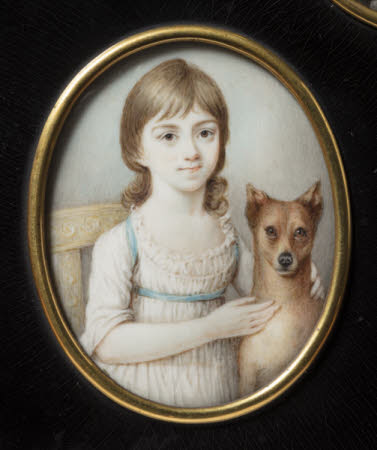Lady Henrietta Antonia Clive, later Lady Williams-Wynn (1786-1835) with a Dog
Anna Tonelli (Florence c.1763 – Florence 1846)
Category
Art / Miniatures
Date
1799
Materials
Watercolour on ivory
Measurements
89 mm (H); 70 mm (W); 244 mm (H); 213 mm (W)
Place of origin
England
Order this imageCollection
Powis Castle and Garden, Powys
NT 1181046
Caption
The life and work of Anna Tonelli was profoundly shaped by conflict in Europe and colonial India. A trained portraitist, she built up a clientele in Britain in the 1790s for her intimate pastel likenesses and exhibited at the Royal Academy of Arts. She maintained this professional practice while working as a companion and governess in aristocratic households, including that of the Clives of Powis Castle, Powys. An accomplished singer and harpsichordist, she taught her charges music as well as Italian and drawing. Born in Florence as Anna Nistri, she married the violinist Luigi Tonelli, with whom she had two children in around 1789–90. The arrival of the French Revolutionary Wars in the Italian peninsula, and the disruptions this caused in the portrait market, probably informed her decision to move to Britain alone. Her letters reveal a tact and warmth of personality that must have been invaluable in the complex negotiation between public artistic practice and private domestic service; Henrietta, Lady Clive, described her as ‘a treasure’. However, correspondence also documents the strain of separation from her war-torn country and her own children, whom she supported by her income. These financial considerations led her to accept an invitation from the Clives to accompany them to India in 1798, where Lord Edward Clive had been appointed Governor of Madras by the East India Company. This three-year stay culminated in a 1,000-mile tour through Tipu Sultan’s recently defeated Kingdom of Mysore as part of Lady Clive’s entourage. Tonelli’s skills were deployed for diplomatic aspects of this journey, which pushed her art in new directions. The intricate detail of her portrait of Maharaja Sarahbhoji of Tanjore (NT 1180777) responds to the type of picture that Indian artists, trained in late-Mughal miniature techniques, had developed to appeal to the taste of European colonists, known as ‘Company School’ painting.
Summary
Portrait miniature, watercolour on ivory, Lady Henrietta Antonia Clive, later Lady Williams-Wynn (1786-1835) with a Dog by Anna Tonelli (Florence c.1763 – Florence 1846). c.1799. Oval. Three-quarter-length portrait of a young girl, seated on a wooden bench, turned slightly to the right, gazing slightly to the right, with a dog on the right, which she holds with both hands. She is wearing a white dress with a blue sash, Brown eyes, long light brown hair, aged 11.
Provenance
Accepted by HM Treasury on 21st March, 1963 in lieu of tax, placed on long term loan to the National Trust, then gifted to National Trust on 26th March 1991.
Makers and roles
Anna Tonelli (Florence c.1763 – Florence 1846), miniaturist previously catalogued as attributed to John Smart I (Norwich 1741 – London 1811), miniaturist
References
Conroy, Rachel, Women Artists and Designers at the National Trust, 2025, pp. 86-89

